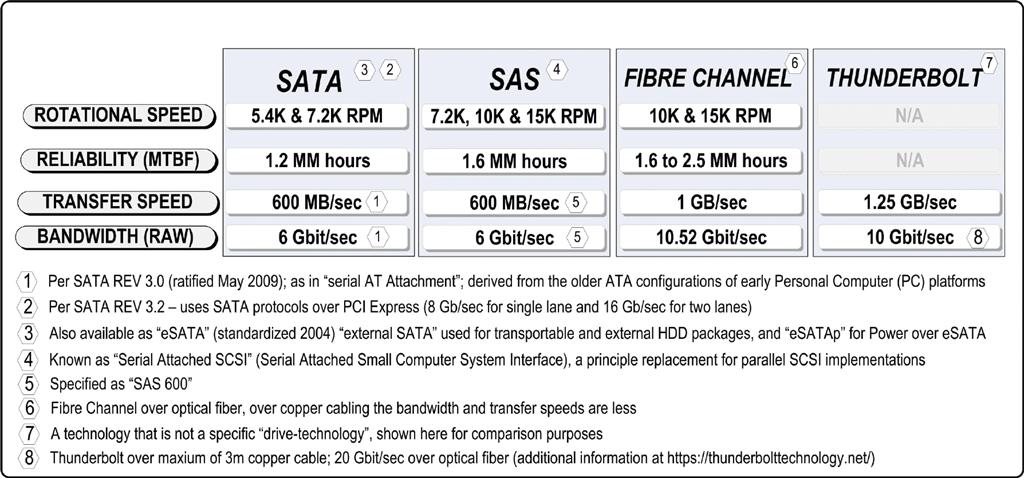Sorting Out SAS and SATA

Karl Paulsen
If you’re looking to buy or upgrade a media storage system there are numerous choices with sometimes puzzling details to consider.
In past articles, we’ve discussed RAID variations, the SAN vs. NAS topic, and explored alternative architectures such as object-based storage. This time the focus will be on drive types— and in this case SAS and SATA—given that selecting an applicable drive type can often be complicated by cost, performance and capacity equations.
Over the past several years, users have been offered a choice among at least three different kinds of rotating magnetic media, aka “hard drives.” The more familiar choices continue to be Serial Attached SCSI (SAS) and Serial ATA (SATA); with the not-to-be-forgotten Fibre Channel (FC) drive varieties, which are still generally associated with high-performance Storage Area Networks (SAN) arrays.
In recent times, new flavors of solid-state drives (SSD) have emerged, which are also referred to as solid-state disks or nonvolatile memory (NVM), as well as the less-often found nonvolatile disks or electronic disks. For this month we’ll hold the subject of iSCSI, yet another interface and drive configuration, and save it for a later time.
A somewhat unfamiliar drive application is the Nearline-SAS (NL-SAS) drive, described as an enterprise-class SATA drive with a fully capable SAS interface and employing SAS components including heads, media and rotational speed characteristics. Storage vendors may offer NL-SAS for SAN arrays, NAS solutions and server systems. Users should understand the differences in these storage components and how they should be employed, based upon the applications for which they serve.
In broad strokes, with SATA disks you get a reasonable performing drive but at a lower cost point compared to SAS and NL-SAS, which is why a lot of SATA drives are sold. While SAS will certainly perform better, SATA drives continue to be found in many mid- and lower-tier mass storage environments.
The professional video industry's #1 source for news, trends and product and tech information. Sign up below.
RELIABILITY AND INTEGRITY
Older SCSI drives have essentially been replaced by SAS disks, marking SAS as the de facto standard for enterprise-class storage. SAS is considered the more reliable of the SATA/SAS flavors, especially when looking at overall performance in high-demand, high-performance conditions.

Drive technology comparisons
(Click to Enlarge)
From the data integrity perspective and in terms of bit error rates (BER), SAS disks are typically an order of magnitude better than either NL-SAS or SATA disks. For example, SAS disks will enjoy a BER on the order of 1 in 10^16 bits (10 quadrillion) bits. SATA disks exhibit bit error rates of one in one quadrillion (1 in 10^15 bits). This may not seem like a big deal, but when large sets of RAIDed drives make up complex, high-bandwidth arrays, the combined BER numbers then become a factor of consideration.
ENTERPRISE-CLASS
For a disk drive to be called “enterprise- class” means the construction and reliability of that drive must meet higher standards such as MTBF, IOPS, etc. One will find that precision SAS disks are built to more exacting standards than others, with a mean time between failure (MTBF) for SAS of 1.6 million hours vs. 1.2 million hours for SATA, a difference of 46 years between SAS (with a longer life of 182 years) vs. SATA (with a shorter life of 136 years).
Of course, we all know that the actual life is probably much shorter in real implementations, and that true system MTBF factors involve many additional or outside influences.
Disk controllers are another set of performance characteristics that make up the complete disk set application. For SAS disks, the controller includes many additional commands that are used to manage and control the disks; which is why SAS is considered the more efficient choice over SATA.
IOPS BALANCING ACT
With availabilities in 10K and 15K RPM speeds, SAS drives will provide you with a higher IOPS per physical disk, which is why, when striving for high-bandwidth needs, SAS drives will achieve that higher performance mark on a drive-type to drive-type comparison.
The cost per IOPS is very important, thus a strategic balancing act is required. When overall storage capacity must be equaled (compared to SATA or NL-SAS equivalent capacities), users must be willing to buy more of the faster SAS disks (thus more spindles) in order to balance the capacity and IOPS performance equations.
Users must truly understand their application, capacity needs and demand requirements. For example, for nearline applications where IOPS and reliability are not as important as the cost per gigabyte, an NL-SAS may better fit the bill. From a fabrication standpoint, the NL-SAS disk is simply a collection of SATA platters that employ the native command sets of an SAS drive. The NL-SAS drive will still provide the enterprise features that come with SAS, but with less reliability. So don’t expect to exercise an NL-SAS array as you would for the stringent editing-like applications that have very high write activities. NL-SAS should be utilized for just what the name means: “a nearline storage component” in a multitier storage configuration.
CONTROLLERS AND HOST I/O
High-performance storage systems will frequently have dual controllers, supplemented by multiple gigabytes of RAM, battery backup and support for dozens to the low one-hundreds of individual drives. Host I/O interfaces will be selected based upon the external interface to the network. Interface options can include from four to eight 8 Gbps Fibre Channel, multiple 6 Gb SAS connections or 1 to 10 GbE iSCSI interfaces.
These are just some of the basic options to consider when selecting drive types and their associated interfaces. Additional specifications, such as SAN readiness, filesystem and metadata controllers are still necessary topics that you’ll need to address, which will impact how and for what applications those storage architectures will support.
Karl Paulsen, CPBE and SMPTE Fellow, is the CTO at Diversified Systems. Read more about other storage topics in his current book “Moving Media Storage Technologies.” Contact Karl atkpaulsen@divsystems.com.

Karl Paulsen recently retired as a CTO and has regularly contributed to TV Tech on topics related to media, networking, workflow, cloud and systemization for the media and entertainment industry. He is a SMPTE Fellow with more than 50 years of engineering and managerial experience in commercial TV and radio broadcasting. For over 25 years he has written on featured topics in TV Tech magazine—penning the magazine’s “Storage and Media Technologies” and “Cloudspotter’s Journal” columns.
